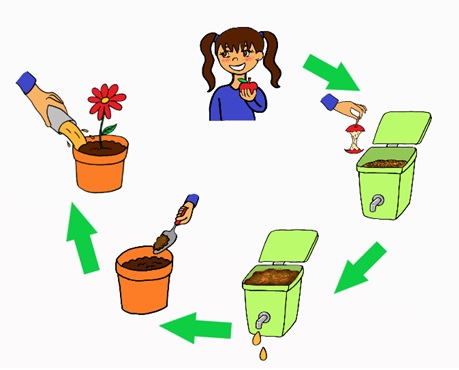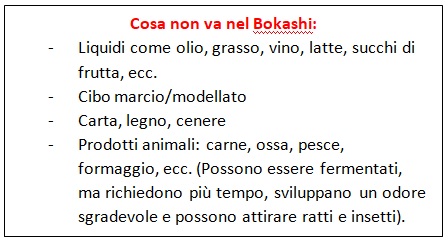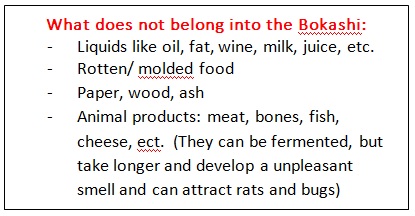IT – Che cos’è il bokashi?
Il bokashi è materia organica fermentata. La materia organica, ad esempio i rifiuti della cucina o del giardino, viene lavorata in un ambiente povero di ossigeno. Rispetto a un normale compost, in cui la materia organica viene lavorata in un ambiente ricco di ossigeno, nel Bokashi finito rimangono più sostanze nutritive, l’odore si riduce e ci vogliono solo due o tre settimane.

Come si usa il Bokashi?
Il Bokashi finito è un fertilizzante efficace, che può essere utilizzato in giardino o per la coltivazione in vaso. Poiché il pH è molto basso, il Bokashi deve rimanere nel terreno per due settimane prima di entrare in contatto con le piante o essere messo nel terreno a distanza dalle piante. Il Bokashi può anche essere usato per accelerare il processo di compostaggio in un normale compost. Oltre al Bokashi finito, si sviluppa un liquido. Questo succo di Bokashi può essere utilizzato come fertilizzante (mescolato con acqua 1:20 o 1:100 per piante sensibili), per la pulizia dei tubi e come protettivo per le piante (40 ml di succo di Bokashi per 500 ml di acqua). Il Bokashi può essere conservato in un sacchetto ermetico per alcuni mesi, mentre il succo di Bokashi deve essere utilizzato immediatamente.
Come fare il Bokashi?
È necessario:
- Secchio Bokashi
- EM-a (microrganismi efficaci)
- Materia organica
- 1. Preparate il secchio: Deve avere un filtro sul fondo e uno scarico.
- 2. Riempite il secchio: Riempite la materia organica. È meglio tagliare tutto in piccoli pezzi per accelerare il processo. Premete ogni strato per eliminare l’aria. Spruzzate l’EM-a su ogni strato.
- 3. Ripetere la fase fino a riempire il secchio. Assicurarsi di chiudere il secchio ermeticamente ogni volta. Se il secchio è pieno solo a metà, si può usare un sacchetto di sabbia o qualcosa di simile per ridurre l’aria all’interno.
- 4. Rilasciate il succo Bokashi aprendo lo scarico ogni giorno.
- 5. Aspettate due o tre settimane. Dopodiché, il Bokashi finito dovrebbe avere un odore un po’ aspro.
Che cos’è il compost?
Il compost è un contenitore in cui viene raccolta la materia organica, ad esempio gli scarti della cucina e del giardino. Nel compost, il biota del suolo trasforma la materia organica, sotto l’effetto dell’ossigeno, in humus.
Come si usa il compost?
Dopo quattro-otto settimane il compost può essere utilizzato come fertilizzante. Il compost rimasto nella compostiera per almeno sei mesi può essere usato come fertilizzante e ha qualità migliorative del suolo. Dopo due o tre anni il compost ha qualità migliorative per il terreno.
Come fare il compost?
Sono necessari:
- Bidone per il compost
- Materia organica
1. Costruite o acquistate una compostiera adatta alle vostre esigenze e alla quantità di materia organica prodotta. Posizionatelo in un ambiente semi-ombreggiato a contatto con il terreno. Potete mettere un filo di ferro sotto di esso per evitare che i roditori vi entrino.
2. Riempite la vostra materia organica. Cercate di mescolare diversi tipi di materia organica per garantire un buon processo. Potete riempire il compost con materia fresca mentre quella più vecchia ha già iniziato il processo.
3. Mantenete il compost umido. Innaffiatelo quando è troppo secco e aggiungete materia organica secca quando è troppo umido.
4. Girate il materiale del compost ogni pochi mesi. In questo modo si favorisce l’ingresso dell’aria nel compost e si previene la muffa. 5. Aspettate che il compost raggiunga lo stadio desiderato.
ENG – What is Bokashi?
Bokashi is fermented organic matter. The organic matter, e.g. kitchen or garden waste, is processed in an oxygen-deficient environment. In comparison to a normal compost, where the organic matter is processed in an oxygen-rich environment, more nutrients remain in the finished Bokashi, the smell development is reduced and it takes only two to three weeks.
How to use Bokashi?
The finished Bokashi is an efficient fertilizer, that can be used in the garden or for pot planting. Since the pH is quiet low, the Bokashi needs to be in the soil for two weeks before getting into contact with the plants or put into the soil with some distant to the plants. Bokashi can also be used to accelerate the composting process in a normal compost. Besides the finished Bokashi, a liquid develops. This Bokashi juice can be used as a fertilizer (mixed with water 1:20 or 1:100 for sensible plants), for pipe cleaning and as a plant protectant
(40 ml Bokashi juice for 500 ml water). The Bokashi can be stored in an airtight bag for a few months, while the Bokashi juice should be used immediately.
How to produce Bokashi?
You need:
- Bokashi-Bucket
- EM-a (Effective Microorganisms)
- Organic matter
- Prepare the bucket: It should have a strainer at the bottom and a drain.
- Fill the bucket: Fill in your organic matter. It is best to cut everything into small pieces to accelerate the process. Press down every layer to get rid of the air. Spray the EM-a on each layer.
- Repeat step till the bucket is full. Make sure to close the bucket airtight each time. If the bucket is only half full, you can use a sandbag or something similar to reduce the air inside.
- Release the Bokashi juice by opening the drain daily.
- Wait two to three weeks. After that, the finished Bokashi should smell a bit sour.
What is compost?
A compost is a container in which organic matter, e.g. kitchen and garden waste, is collected. In the compost, soil biota transforms organic matter, under oxygen use, into humus.

How to use compost?
After four to eight weeks the compost can be used as a fertilizer. Compost that is in the compost bin for at least six months can be used as a fertilizer and has soil improving qualities. After two to three years the compost has soil improving qualities.
How to do compost?
You need:
- Compost bin
- Organic matter
- Build or buy a compost bin that suits your needs and amount of organic matter produced. Place it in a half shady environment with contact to soil. You can put a chicken wire underneath to prevent rodents from entering.
- Fill in your organic matter. Try to mix different types of organic matter to ensure a good process. You can fill the compost with fresh matter while the older one already started the progress.
- Keep the compost humid. Water it when it is too dry and add dry organic matter when it is too wet.
- Turn the compost material over every few months. That helps air to get into the compost and prevents mildew.
- Wait till the compost reaches the stage you need.
